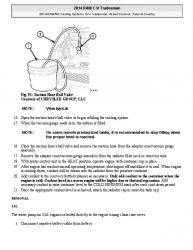RAM C/V Tradesman 2012-2017 Workshop Repair & Service Manual
Catalog:
Model:
Complete repair workshop manual with electrical wiring diagrams contains service, maintenance, and troubleshooting information for the 2012-2017 RAM C/V, C/V Tradesman. Diagnostic and repair procedures are covered in great detail to repair, maintain, rebuild, refurbish or restore your vehicle like a professional mechanic in local service/repair workshop. This cost-effective quality manual is 100% complete and intact as should be without any missing pages. It is the same factory shop manual used by dealers that guaranteed to be fully functional to save your precious time.
This manual for 2012-2017 RAM C/V, C/V Tradesman is divided into different sections. Each section covers a specific component or system and, in addition to the standard service procedures, includes disassembling, inspecting, and assembling instructions. A table of contents is placed at the beginning of each section. Pages are easily found by category, and each page is expandable for great detail. It is in the cross-platform PDF document format so that it works like a charm on all kinds of devices. You do not need to be skilled with a computer to use the manual.
MAKE: RAM / Dodge
MODEL: RAM C/V, RAM C/V Tradesman (a.k.a. RAM Cargo Tradesman, Dodge Grand Caravan C/V)
YEAR: 2012 2013 2014 2015 2016 2017
EXCERPT:
2014 ENGINE Cooling System - C/V Tradesman, Grand Caravan, Town & Country
LEAK TESTING
Fig. 2: Pressure Testing
WARNING: The warning words "DO NOT OPEN HOT" on the radiator pressure cap is a safety precaution. When hot, pressure builds up in cooling system. To prevent scalding or injury, the radiator cap should not be removed while the system is hot or under pressure.
With engine not running, remove radiator pressure cap and wipe the radiator filler neck sealing seat clean. The radiator should be full.
Attach the Cooling System Tester (special tool #7700, Tester, Cooling System) or equivalent to the radiator and apply 104 kPa (15 psi) pressure. If the pressure drops more than 13.8 kPa (2 psi) in 2 minutes, inspect all points for external leaks.
Fig. 3: Pressure Testing Cooling System
1 - COOLING SYSTEM PRESSURE TESTER
2 - COOLANT RECOVERY PRESSURE CONTAINER
All radiator and heater hoses should be shaken while at 104 kPa (15 psi), since some leaks occur only while driving due to engine movement.
If there are no external leaks, after the gauge dial shows a drop in pressure, detach the tester. Start engine and run until the thermostat opens, allowing the coolant to expand. Reattach the cooling system tester. If the needle on the dial fluctuates it indicates a combustion leak, usually a head gasket leak.
WARNING: With tool in place, pressure will build up fast. Excessive pressure built up, by continuous engine operation, must be released to a safe pressure point. Never permit pressure to exceed 138 kPa (20 psi).
If the needle on the dial does not fluctuate, raise the engine RPM a few times. If an abnormal amount of coolant or steam emits from the tailpipe, it may indicate a coolant leak caused by a faulty head gasket, cracked engine block, or cracked cylinder head.
There may be internal leaks that can be determined by removing the oil dipstick. If water globules appear intermixed with the oil it will indicate an internal leak in the engine. If there is an internal leak, the engine must be disassembled for repair.
COOLING SYSTEM FLOW CHECK
To determine whether coolant is flowing through the cooling system, use one of the following procedures:
PREFERRED METHOD
Do not remove the cooling system pressure cap or any hose with the system hot and under pressure because serious burns from coolant can occur.
Remove pressure cap when engine is cold. Remove small amount of coolant. Idle engine until thermostat opens. You should observe coolant flow while looking down the filler neck. Once flow is detected install the pressure cap. Replace removed coolant into coolant recovery container.
ALTERNATIVE METHOD
If engine is cold, idle engine until normal operating temperature is reached. Feel the upper radiator hose. If it is hot, coolant is circulating.
PRELIMINARY CHECKS
ENGINE COOLING SYSTEM OVERHEATING
Establish what driving conditions caused the complaint. Abnormal loads on the cooling system such as the following may be the cause:
Prolonged idle
Very high ambient temperature
Slight tail wind at idle
Slow traffic
Traffic jams
High speed or steep grades
Driving techniques that avoid overheating are:
Idle with A/C off when temperature gauge is at end of normal range.
These charts are to be used as a quick-reference only.
...





